The 3D Cloud Furniture Shopping Trends Study 2025 uncovers a rapidly evolving retail landscape where digital and in-store shopping are more connected than ever. In this second wave of research, we found shoppers increasingly rely on 3D tools like product configurators and 3D room planners to visualize purchases while AI and immersive tech reshape the buying journey. This year’s study explores the key trends driving these shifts and how retailers can turn innovation into real value.
- Background and objectives
- Methodology
- How hybrid shopping trends evolve
- Why people shop for furniture in store first
- Design needs and attitudes
- 3D solves visualization challenges
- 3D room planner benefits and usage
- 3D product configurator benefits and usage
- 3D visualization and the future of furniture shopping
- 3D Cloud Furniture Shopping Trends Study 2025 ebook download
3D Cloud Furniture Shopping Trends 2025 background and objectives
3D Cloud, a company specializing in 3D product visualization platforms, continues to empower enterprise retailers to innovate next-generation customer experiences. We collaborated with Provoke Insights to gather valuable new data including:
- Compare in-store and online retail experiences.
- Identify challenges related to visualizing configurable products and room layouts.
- Explore the role of 3D technology in the furniture buying process.
- Assess the demand, interest, and user experience with a 3D tool for visualizing room layouts and configurable furniture options.
3D Furniture Shopping Trends 2025 methodology
In this second wave of research, Provoke Insights developed and conducted a 50-question online survey among 400 furniture purchasers. All participants met the following criteria.
- Purchased furniture in the last 6 months
- Has a household income of $50K+
- Ages 25-69
- Lives in the United States
Hybrid shopping dominates
Hybrid shopping remains the dominant approach for furniture buyers, particularly those leveraging 3D room planners to bridge online and in-store experiences.
Consumers’ motivations are clear–price negotiation is driving in-store visits, while conveniences, price comparisons, and wider selection fuel online purchases.
The motivation to shop in stores first and then buy online has increased by 40%.
Compared to the 3D Cloud Furniture Shopping Trends Study 2024 (last wave), we noticed more shoppers are now visiting stores first and finalizing their purchases online.
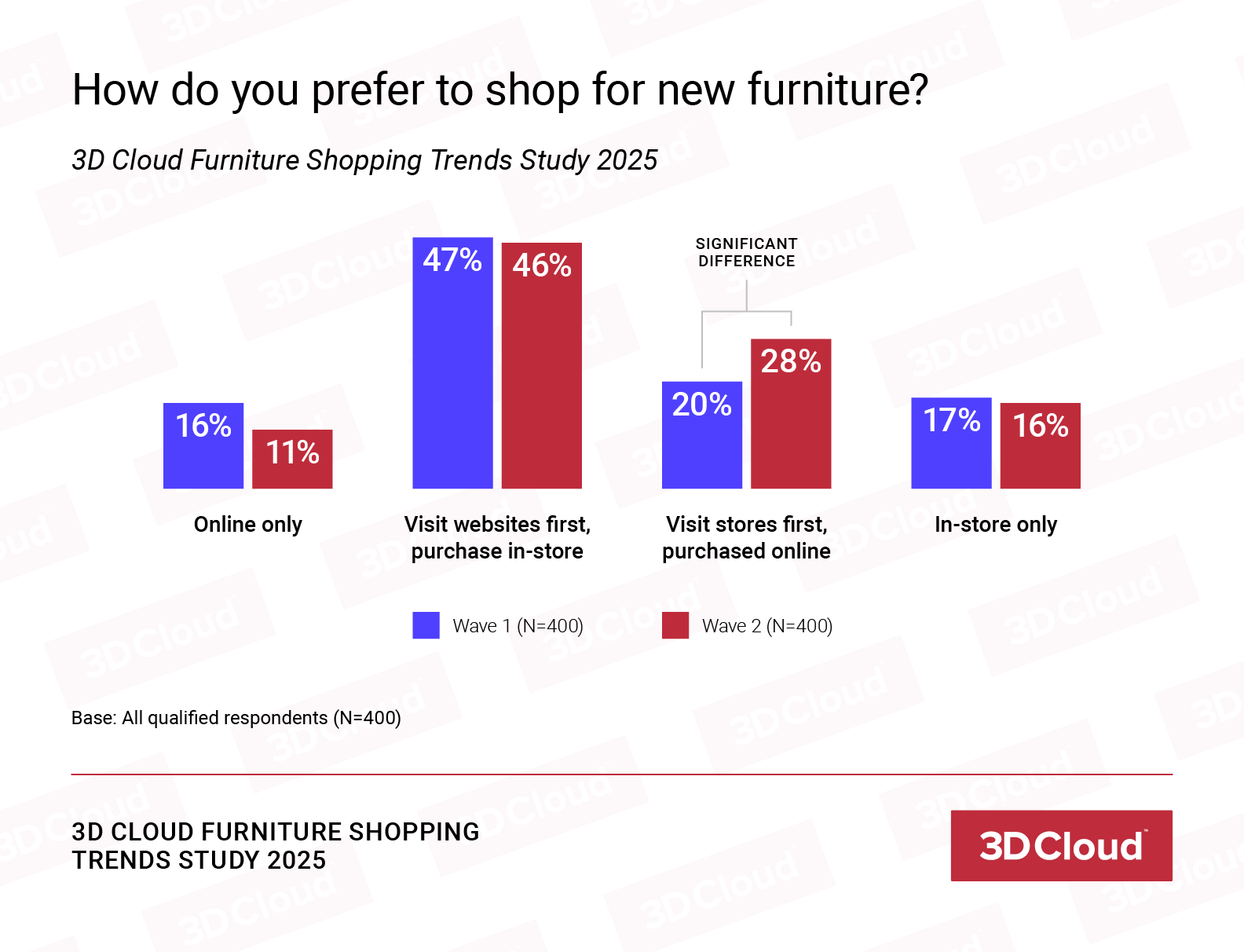
Reasons for furniture shopping by visiting stores first, before visiting websites
A hybrid experience remains the most popular way to shop for furniture. Here are some reasons why people are shopping for furniture in-store first and finalizing their purchases online:
- “Once I see it in the store, it’s so much easier to order it online and have it by the time I want.”
- “It’s easier to have all items delivered directly to my house.”
- “I like to see how item physically looks and feels. Then I purchase online for a better price.”
- “I can get the delivery for free and at a discount.”

Variety and precision are crucial in online furniture shopping, as most consumers expect to view multiple realistic images that accurately represent the product.
Shoppers are highly receptive to 3D imagery provided the 3D representation is true to the actual product.
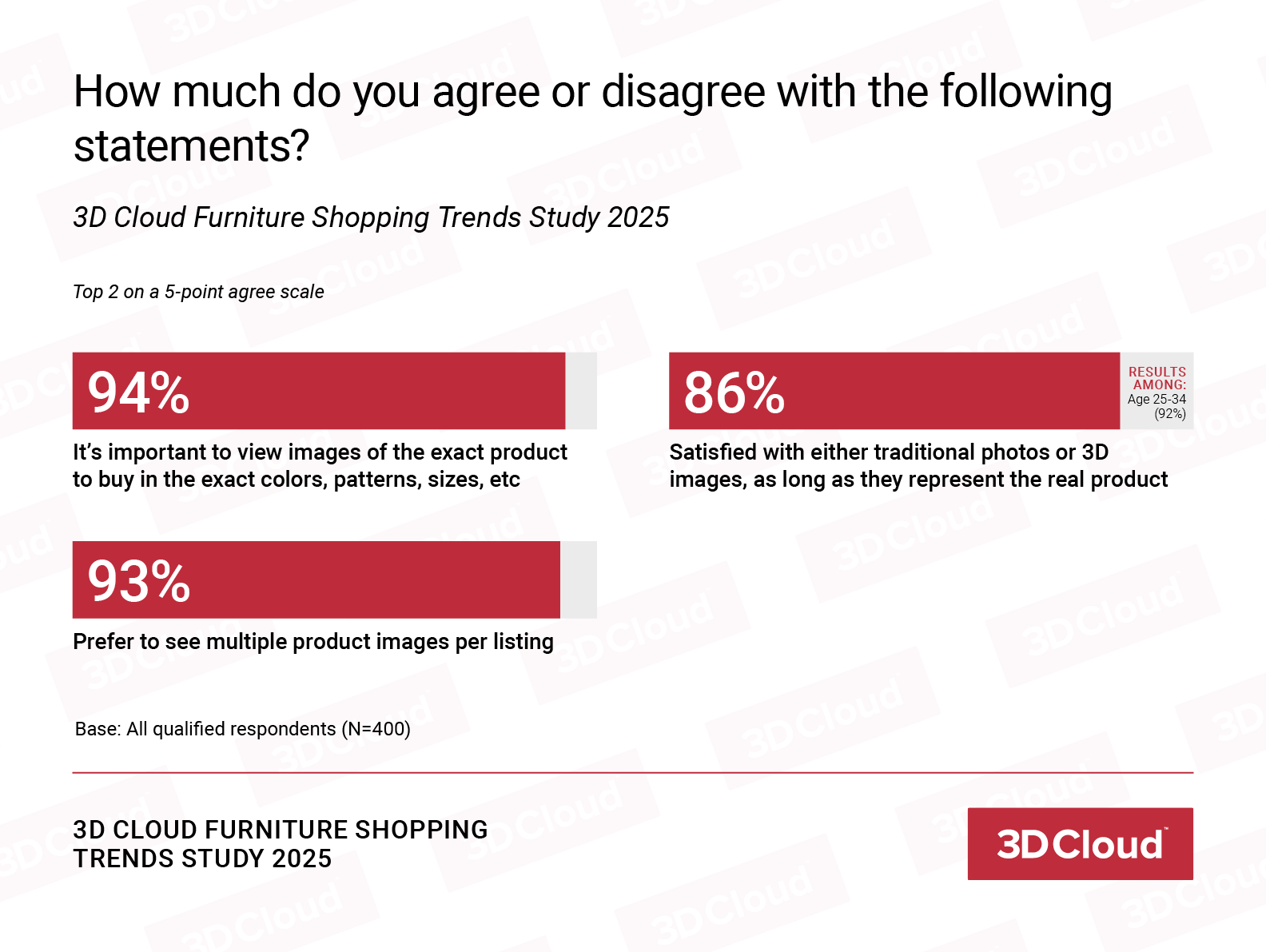
3D solves visualization challenges
Shoppers love personalizing furniture, but more than half struggle to visualize how store-bought pieces will fit in their homes. Shoppers who live in homes worth $500K+ or are under 50 years old, want more in-store tools to visualize furniture in their spaces.
Furniture buyers are also strongly interested in online tools that allow them to configure different product options, rotate products to view them from all angles, zoom in closely, and visualize in their own space through augmented reality.
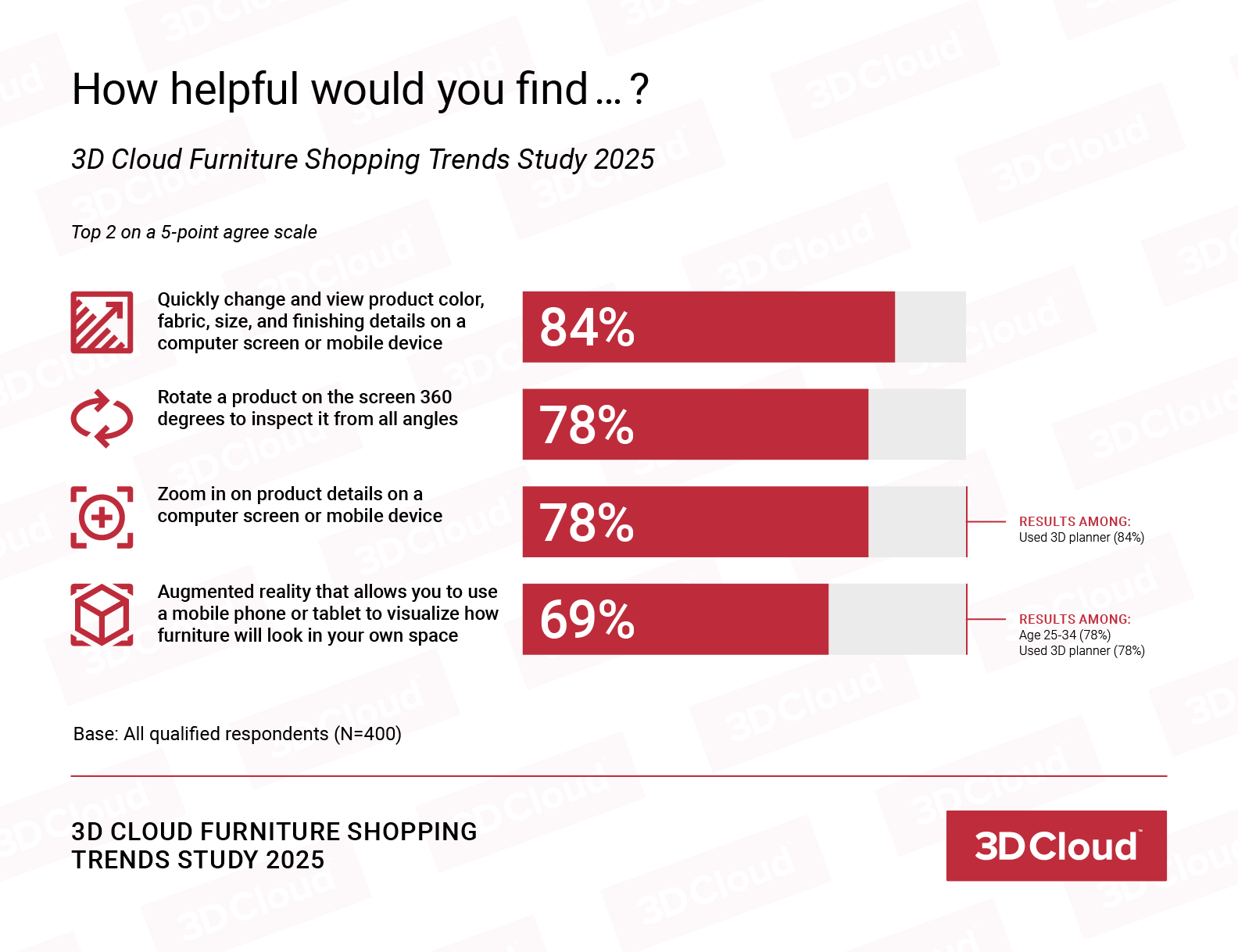
3D room planner benefits and usage
Furniture shoppers are becoming increasingly more reliant on 3D room planners compared to the last wave. The number of consumers who use a 3D room planner while shopping for furniture has increased by more than a third.
They said it helped them with measurements and imagining how the furniture would look in a room. They also found the process more enjoyable than past furniture purchases without using the tool.
Those using room planners are more likely to be aged 35-49, shop both online and in-store, and live in homes worth $500K or more. Interest in using a 3D room planner again in the future is high.
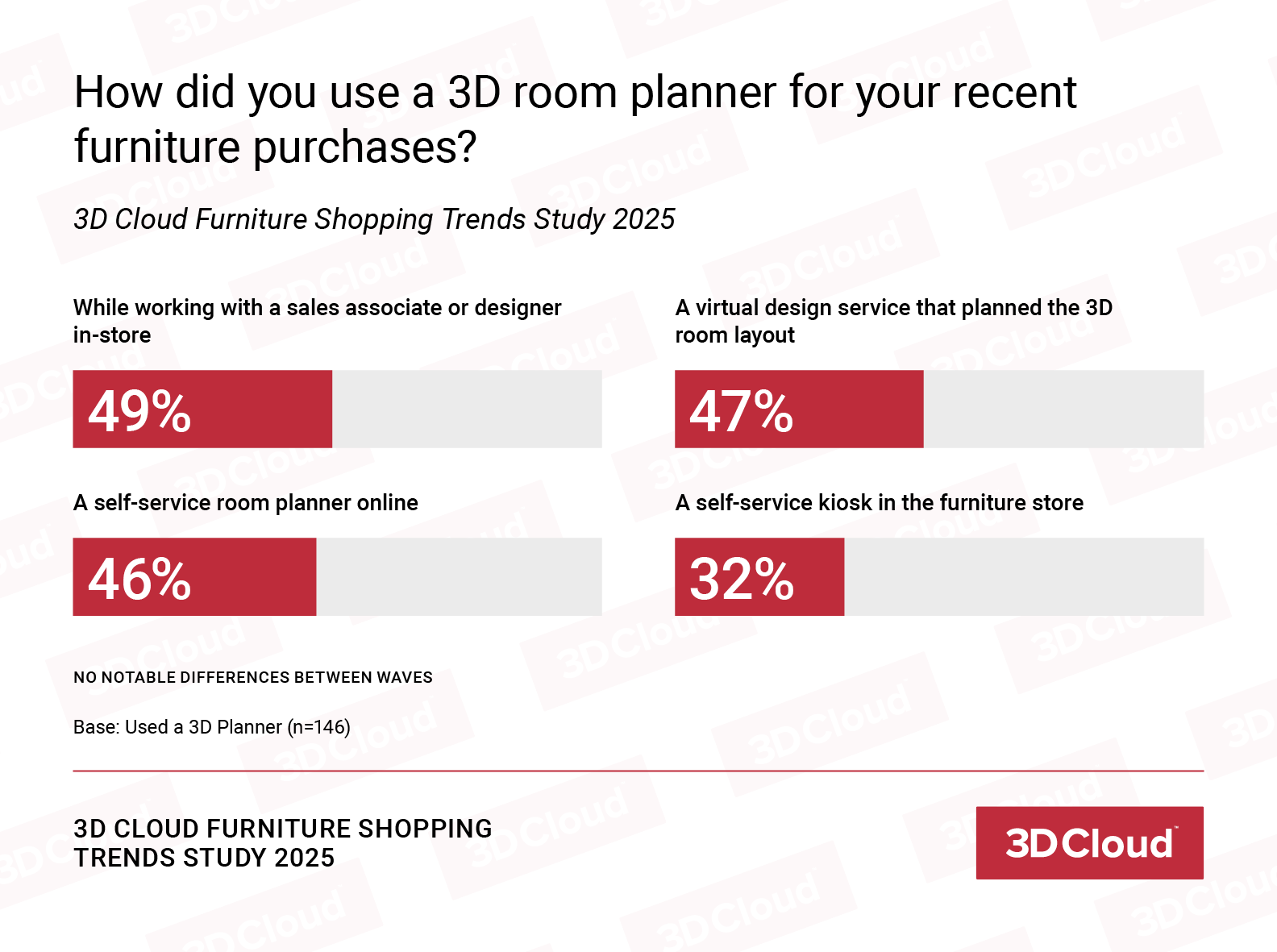
Consumers like working with sales associates or designers in-store while using 3D room planners to help them visualize how furniture will look within their actual floorplan.
- “It was pretty awesome at giving me an accurate visualization of what the furniture would actually look like in my room or home.”
- “I really enjoyed how it gave me a better visualization of what my house would look like.”
- “It was very helpful being able to see all angles of a product and even place the item in a picture of my actual room.”
- “It helps you see if the furniture is going to fit in the room and how it will look.”
3D product configurator benefits and usage
72% customize their furniture purchases. The top options customized were color, fabric/material, and size.
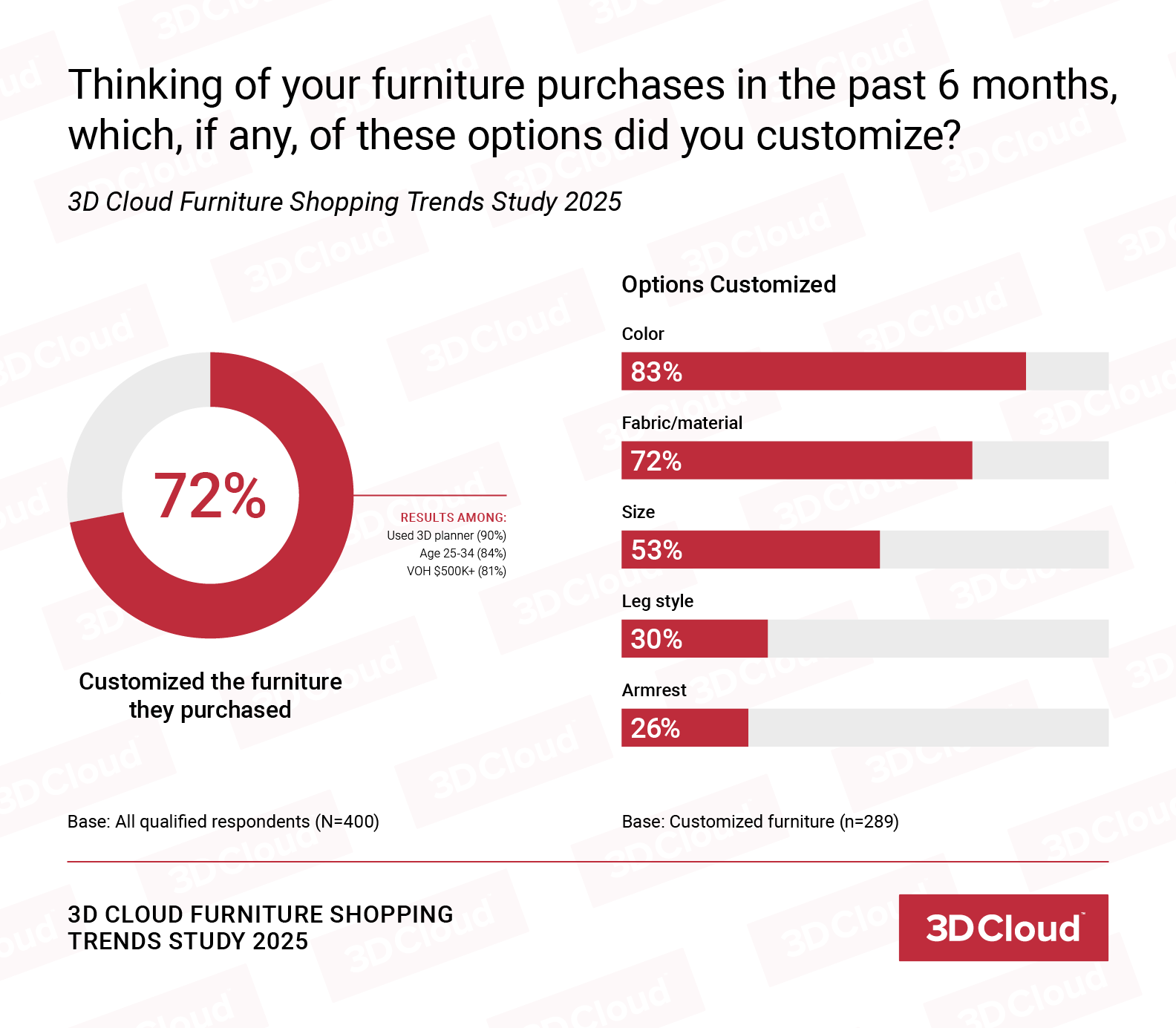
Among those who customized their furniture, nearly half utilized a 3D product configurator. That’s a 25% growth from the last wave. Most commonly, they use it through self-service on a website or work with an in-store salesperson or designer. 88% of users found the 3D configurator very helpful. They said it gave them confidence in their furniture-buying decisions.

Nearly two-thirds of furniture shoppers who did not use a 3D product configurator are interested in using it in the future, especially those who struggle to visualize their furniture purchases.
Self-service kiosks in the store are seeing a marked rise in popularity compared to the last wave.
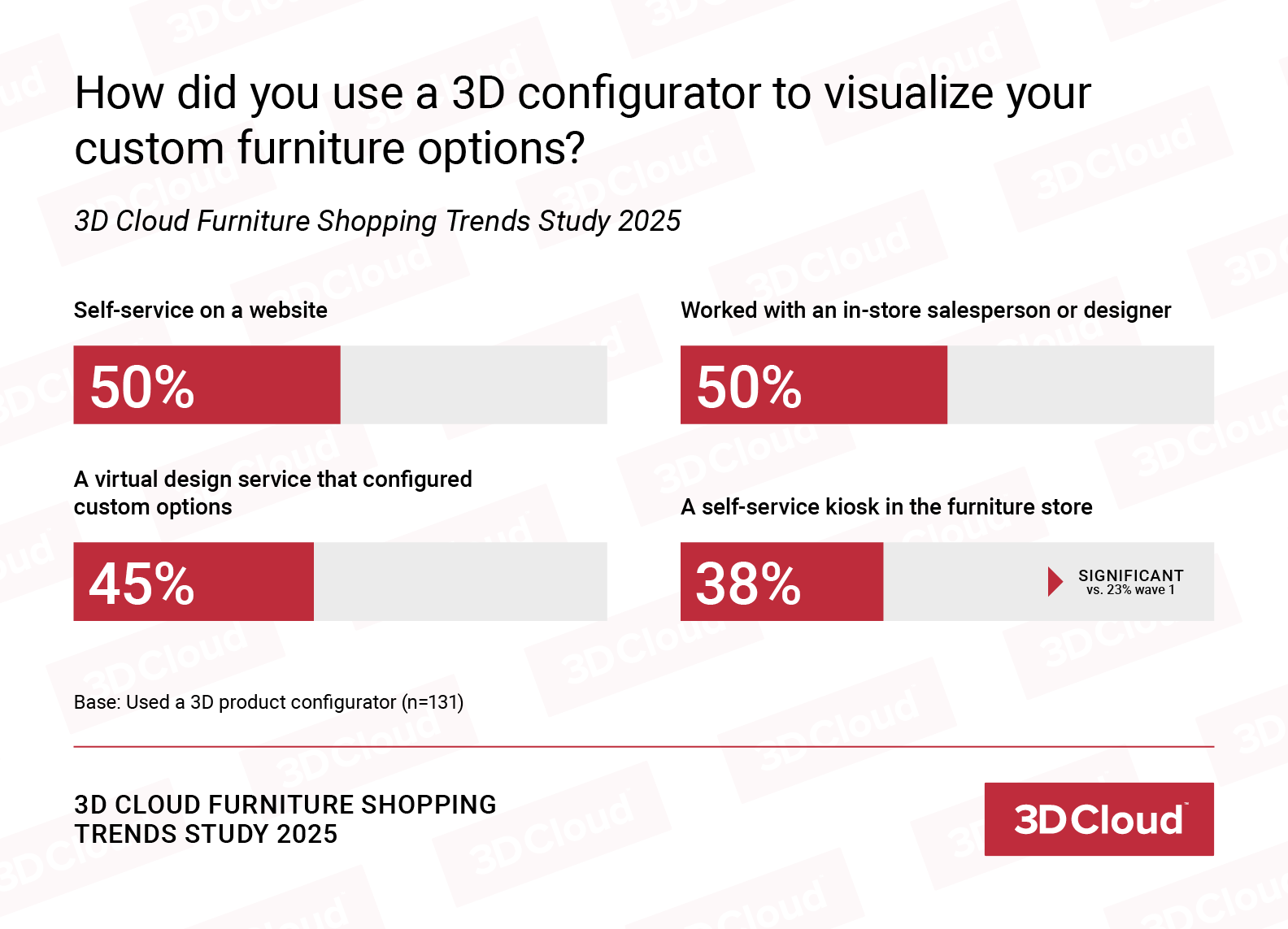
Using 3D room planners and configurators is crucial for furniture stores aiming to enhance customer experiences.
- 61% of those who have yet to try the planner are very interested in this type of product.
- 80% say 3D visualization increases confidence in their purchase decisions.
- 92% found the 3D room planner makes the experience more enjoyable.
- 83% see the 3D planner as very helpful in making final furniture purchase decisions.
Here are some experiences that highlight how 3D product configurators improve buyer confidence:
- “It was very helpful to see the different options that were available. I got a better sense of the final product.”
- “My experience was amazing. I felt like I can control it and can re-design how I like.”
- “Using the 3D product configurator was engaging; it allowed me to customize furniture easily and visualize my choices.
- “I like the fact that you can change the color and change the textures, the patterns, and the furniture to your liking.”
These statements highlight how 3D product configurators help users better visualize color combinations, patterns, and overall visual appearance, boosting their confidence in purchase decisions.
3D visualization and the future of furniture shopping
3D-powered shopping experiences are setting a new standard for furniture retail.

- Three-quarters want to use 3D visualization whenever shopping for furniture.
- Two-thirds prefer shopping at retailers who offer 3D visualization and are more likely to stay loyal to retailers that offer this service.
- 71% prefer to use free design services when available, especially shoppers age 25-34 (85%), higher home value shoppers (79%), and those who previously used a room planner (80%).
- 64% of those who did not use a 3D visualization tool while shopping for furniture wished they had.
Our data throughout this report shows increasing preferences for 3D visualization and configuration, with adoption rates rising significantly compared to the 3D Cloud Furniture Shopping Trends Study 2024. More shoppers now recognize the value–many regret not using them in previous purchases.
Download the complete 3D Cloud Furniture Shopping Trends 2025 report










